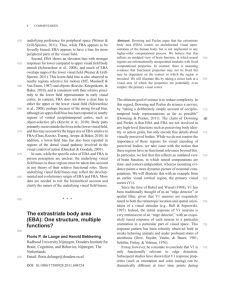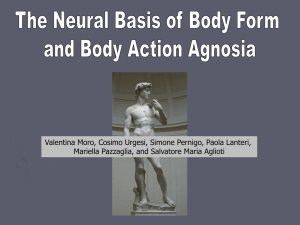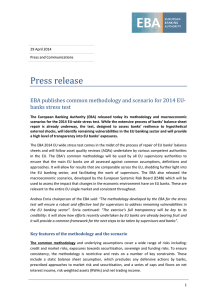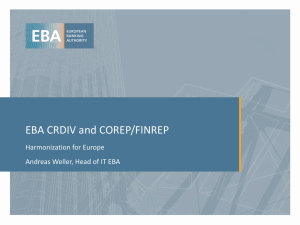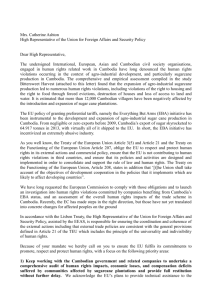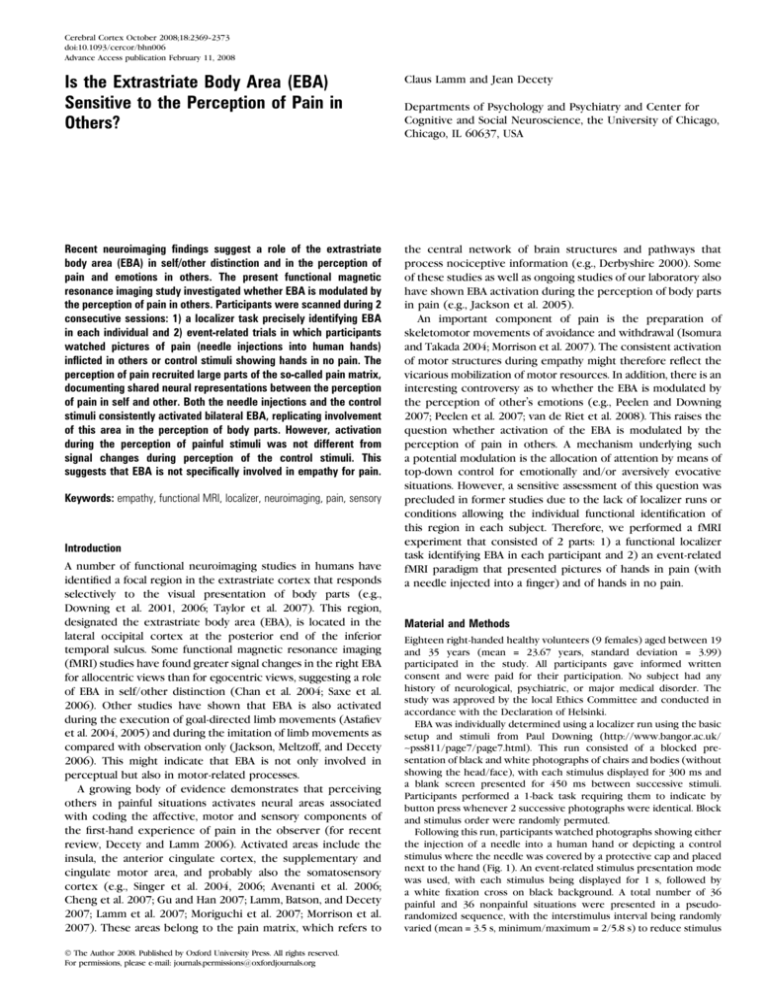
Cerebral Cortex October 2008;18:2369--2373
doi:10.1093/cercor/bhn006
Advance Access publication February 11, 2008
Is the Extrastriate Body Area (EBA)
Sensitive to the Perception of Pain in
Others?
Claus Lamm and Jean Decety
Recent neuroimaging findings suggest a role of the extrastriate
body area (EBA) in self/other distinction and in the perception of
pain and emotions in others. The present functional magnetic
resonance imaging study investigated whether EBA is modulated by
the perception of pain in others. Participants were scanned during 2
consecutive sessions: 1) a localizer task precisely identifying EBA
in each individual and 2) event-related trials in which participants
watched pictures of pain (needle injections into human hands)
inflicted in others or control stimuli showing hands in no pain. The
perception of pain recruited large parts of the so-called pain matrix,
documenting shared neural representations between the perception
of pain in self and other. Both the needle injections and the control
stimuli consistently activated bilateral EBA, replicating involvement
of this area in the perception of body parts. However, activation
during the perception of painful stimuli was not different from
signal changes during perception of the control stimuli. This
suggests that EBA is not specifically involved in empathy for pain.
the central network of brain structures and pathways that
process nociceptive information (e.g., Derbyshire 2000). Some
of these studies as well as ongoing studies of our laboratory also
have shown EBA activation during the perception of body parts
in pain (e.g., Jackson et al. 2005).
An important component of pain is the preparation of
skeletomotor movements of avoidance and withdrawal (Isomura
and Takada 2004; Morrison et al. 2007). The consistent activation
of motor structures during empathy might therefore reflect the
vicarious mobilization of motor resources. In addition, there is an
interesting controversy as to whether the EBA is modulated by
the perception of other’s emotions (e.g., Peelen and Downing
2007; Peelen et al. 2007; van de Riet et al. 2008). This raises the
question whether activation of the EBA is modulated by the
perception of pain in others. A mechanism underlying such
a potential modulation is the allocation of attention by means of
top-down control for emotionally and/or aversively evocative
situations. However, a sensitive assessment of this question was
precluded in former studies due to the lack of localizer runs or
conditions allowing the individual functional identification of
this region in each subject. Therefore, we performed a fMRI
experiment that consisted of 2 parts: 1) a functional localizer
task identifying EBA in each participant and 2) an event-related
fMRI paradigm that presented pictures of hands in pain (with
a needle injected into a finger) and of hands in no pain.
Keywords: empathy, functional MRI, localizer, neuroimaging, pain, sensory
Introduction
A number of functional neuroimaging studies in humans have
identified a focal region in the extrastriate cortex that responds
selectively to the visual presentation of body parts (e.g.,
Downing et al. 2001, 2006; Taylor et al. 2007). This region,
designated the extrastriate body area (EBA), is located in the
lateral occipital cortex at the posterior end of the inferior
temporal sulcus. Some functional magnetic resonance imaging
(fMRI) studies have found greater signal changes in the right EBA
for allocentric views than for egocentric views, suggesting a role
of EBA in self/other distinction (Chan et al. 2004; Saxe et al.
2006). Other studies have shown that EBA is also activated
during the execution of goal-directed limb movements (Astafiev
et al. 2004, 2005) and during the imitation of limb movements as
compared with observation only (Jackson, Meltzoff, and Decety
2006). This might indicate that EBA is not only involved in
perceptual but also in motor-related processes.
A growing body of evidence demonstrates that perceiving
others in painful situations activates neural areas associated
with coding the affective, motor and sensory components of
the first-hand experience of pain in the observer (for recent
review, Decety and Lamm 2006). Activated areas include the
insula, the anterior cingulate cortex, the supplementary and
cingulate motor area, and probably also the somatosensory
cortex (e.g., Singer et al. 2004, 2006; Avenanti et al. 2006;
Cheng et al. 2007; Gu and Han 2007; Lamm, Batson, and Decety
2007; Lamm et al. 2007; Moriguchi et al. 2007; Morrison et al.
2007). These areas belong to the pain matrix, which refers to
The Author 2008. Published by Oxford University Press. All rights reserved.
For permissions, please e-mail: journals.permissions@oxfordjournals.org
Departments of Psychology and Psychiatry and Center for
Cognitive and Social Neuroscience, the University of Chicago,
Chicago, IL 60637, USA
Material and Methods
Eighteen right-handed healthy volunteers (9 females) aged between 19
and 35 years (mean = 23.67 years, standard deviation = 3.99)
participated in the study. All participants gave informed written
consent and were paid for their participation. No subject had any
history of neurological, psychiatric, or major medical disorder. The
study was approved by the local Ethics Committee and conducted in
accordance with the Declaration of Helsinki.
EBA was individually determined using a localizer run using the basic
setup and stimuli from Paul Downing (http://www.bangor.ac.uk/
~pss811/page7/page7.html). This run consisted of a blocked presentation of black and white photographs of chairs and bodies (without
showing the head/face), with each stimulus displayed for 300 ms and
a blank screen presented for 450 ms between successive stimuli.
Participants performed a 1-back task requiring them to indicate by
button press whenever 2 successive photographs were identical. Block
and stimulus order were randomly permuted.
Following this run, participants watched photographs showing either
the injection of a needle into a human hand or depicting a control
stimulus where the needle was covered by a protective cap and placed
next to the hand (Fig. 1). An event-related stimulus presentation mode
was used, with each stimulus being displayed for 1 s, followed by
a white fixation cross on black background. A total number of 36
painful and 36 nonpainful situations were presented in a pseudorandomized sequence, with the interstimulus interval being randomly
varied (mean = 3.5 s, minimum/maximum = 2/5.8 s) to reduce stimulus
Figure 1. Sample stimuli used in the experiment.
predictability and to allow more efficient event-related signal estimation (Donaldson and Buckner 2001). All stimuli were unique shots
taken from 5 different targets, with needles being injected into
different parts of the hand. Injection positions and angles were varied in
order to prevent habituation effects. In a similar vein, stimuli were
presented in 2 runs with equal numbers of trials, with runs being
separated by a short break. Needle positions and angles of the control
stimuli were roughly matched to those of the injections. However, the
plastic cap of the control stimuli never touched the hand and was never
pointing toward it. Participants were asked to evaluate the amount of
pain inflicted in the target in all trials, but actual ratings were requested
only for 10 randomly selected trials per condition. The aim of these
ratings was to collect behavioral data in the scanner and to ensure
engagement of participants in the task. Only a subset of trials had to
be evaluated in order to optimize the design for stimulus-related
responses. Ratings were collected using a visual analog scale (VAS)
with endpoints ‘‘no pain’’ (coded as 0) and ‘‘worst imaginable pain’’
(coded as 100). Participants used their dominant right hand to move
a slider positioned on the VAS. In additional separate blocks, the same
stimuli had to be evaluated for pain unpleasantness using a VAS with
endpoints ‘‘not unpleasant’’ to ‘‘extremely unpleasant’’. Because EBA
responses during this type of rating were identical than during intensity
ratings, we only report the latter here.
fMRI Data Acquisition and Analysis
Magnetic resonance imaging data were acquired on a 3-T head-only
Siemens Magnetom Allegra System equipped with a standard quadrature
2370 EBA and Perception of Pain in Others
d
Lamm and Decety
head coil. T2*-weighted magnetic resonance signal was measured using
a single-shot echoplanar imaging (EPI) sequence (time repetition [TR] =
1810 ms, time echo = 30 ms, flip angle = 80, 30 axial slices/volume with
4.5 mm slice thickness, in-plane resolution = 3.28 3 3.28 mm2). Each run
was preceded by dummy scans ensuring steady-state magnetization
conditions. A total of 500 EPI volumes was acquired in 2 separate runs for
the main experiment, and 179 volumes were acquired for the EBA
localizer run. Stimulus presentation and response collection were
performed using the Presentation software (Neurobehavioural Systems, Albany, CA). Visual stimuli were presented using a backprojection system, and a button box recorded the responses of subjects
(entered using the dominant right hand).
Image processing was carried out using SPM2 (Wellcome Department
of Imaging Neuroscience, London, UK). After preprocessing (slice-timing
correction, correction for head motion, normalization to the EPI
template provided in SPM2, smoothing using a 6-mm full-width halfmaximum isotropic Gaussian kernel), fixed effects general linear models
(GLM) were set up for each subject to model the experimental
conditions (using the standard canonical hemodynamic response
function as a model of hemodynamic responses; high-pass filter with
a frequency cut-off at 128 s). The resulting 1st-level contrast images were
entered into a 2nd-level random effects analysis assessing differences
between injections and control stimuli (contrast injection > control)
with population inference. This whole-brain analysis was interpreted
using a voxel-level threshold of P = 0.01 and a spatial extent threshold of
k = 20, corrected for multiple comparisons across the whole volume
using the false discovery rate approach (Genovese et al. 2002). The
choice of this threshold was determined based on previous studies on
empathy for pain and on power considerations for the current paradigm
(Jackson et al. 2005; Lamm and Decety 2007; Lamm, Batson, and Decety
2007; Lamm et al. 2007; Singer et al. 2004, 2006). The goal of the wholebrain analysis was to assess consistency and validity of the current results
with respect to former reports investigating empathy for pain. We
expected activation in various areas of the so-called pain matrix,
including the anterior insula, medial and anterior cingulate cortex,
inferior parietal, and ventral and dorsomedial premotor cortex.
Region-of-interest (ROI) analyses were performed using the MarsBaR
toolbox, v0.38 (http://www.sourceforge.net/projects/marsbar). The
average signal of all voxels in a certain ROI was extracted for
a peristimulus epoch of 15 TRs (i.e., about 27 s). ROIs for left and
right EBA were defined as activity clusters in left and right lateral
occipital cortices showing higher responses to images of bodies than to
images of nonbodies (contrast bodies > chairs). The mean stereotactic
coordinates from studies reporting EBA coordinates using a similar or
the same localizer as the one we implemented were used as guidance
points for localizing EBA individually (Downing et al. 2001, 2007;
Astafiev et al. 2004; Peelen and Downing 2005; Saxe et al. 2006).
Localization was based on visual inspection of activation maps and the
identification of clusters in lateral occipitotemporal cortex close to
these previously reported coordinates.
Results
Pain Ratings
Figure 2 displays the pain ratings obtained using the VAS.
Ratings show that needle injections were evaluated as
considerably painful for the targets and as more painful than
the control stimuli which were rated as nonpainful (paired
t-test, t18 = 14.903, P < 0.001, g2 = 0.929). Analyzing ratings
separately for the 2 imaging runs revealed that pain ratings of
the 2 runs did not differ (M = 69.71 and M = 69.86 for
injections, M = 3.78 and M = 3.321 for control stimuli; F < 1 for
main effect of run and interaction run 3 condition, repeated
measures analysis of variance).
fMRI Data —Whole-Brain Analysis
The whole-brain analysis of the contrast injections > control
showed activation in large parts of the pain matrix (insula,
medial and anterior cingulate cortex, thalamus, basal ganglia,
inferior parietal, supplementary motor area, dorsal and ventral
premotor areas), as well as in visual areas when contrasting the
2 conditions against the fixation baseline. The whole-brain
analysis also showed significant activation in bilateral lateral
occipitotemporal cortices when contrasting the 2 conditions
against the fixation baseline. Note though that the contrast
injections > control or control > injection did not yield any
significant voxels in the EBA area—even when lowering the
threshold to P = 0.1 (uncorrected), k = 5, to lower the
probability of false negatives (type II error). Figure 3 and
Supplementary Table 1 document this activation pattern and
the involved brain structures, and Supplementary Figure 1
shows activation time courses in areas of the pain matrix.
fMRI Data —EBA Analyses
The localizer run presenting images of chairs and bodies led to
consistent activation in left and right EBA in all participants
(Table 1, Fig. 4). The Montreal Neurological Institute coordinates (mean [standard error]) of these cluster maxima were x =
53.89, y = –66.78, z = 8.33 (1.06, 1.63, 1.54) for the right EBA and
–53.67, –68.11, 9 (1.23, 1.78, 1.34) for the left EBA—both very
similar but slightly more superior as coordinates of this area
reported in previous studies.
The event-related ROI analyses revealed typical hemodynamic responses triggered by the visual stimuli depicting hands
(Fig. 5). Responses were not modulated by the experimental
conditions, though. The main effect ‘‘condition’’ (painful vs.
nonpainful stimuli) and the interaction term were far from
being significant (all Ps > 0.317). The only significant factor was
time—reflecting the amplitude changes of the hemodynamic
responses apparent during the chosen peristimulus analysis
window (left EBA: F14,238 = 17.143, e = 0.151, PGG < 0.001, g2 =
0.502; right EBA: F14,238 = 9.129, e = 0.129, PGG = 0.001, g2 =
0.349). Linear contrasts of peak amplitudes (defined as the
average signal amplitude of poststimulus TRs 3 and 4) were far
from significant too (all Ps > 0.26; calculated using specific
error variances; Boik 1981). Additional post hoc linear contrasts
Table 1
Individual coordinates of cluster maxima in right and left EBA determined using the localizer
contrast body [ chairs
Subject
Figure 2. Pain ratings (mean þ standard error) for needle injections and control
stimuli.
Figure 3. Whole-brain activation for the contrast injection [ control. Shown are
significant clusters (P 5 0.01, k 5 20, false discovery rate corrected) overlaid on
a high-resolution structural magnetic resonance scan in Montreal Neurological
institute (MNI) space. Gray labels indicate slice number in MNI space. SI 5 primary
somatosensory cortex, INS 5 insular cortex, AI 5 anterior insular cortex, vPM 5
ventral premotor cortex, SMA 5 supplementary motor area, MCC/ACC 5 medial/
anterior cingulate cortex, PAG 5 periaqueductal gray.
1
2
3
4
5
6
7
8
9
10
11
12
13
14
15
16
17
18
Left hemisphere
Right hemisphere
x
y
z
x
y
z
50
40
54
52
56
52
52
56
60
56
56
62
52
50
54
50
50
64
74
80
58
74
64
78
76
72
56
68
72
62
72
56
68
72
68
56
0
0
16
18
20
10
4
4
8
12
8
10
16
10
10
4
4
8
62
50
56
44
54
54
56
56
56
46
54
60
52
56
52
60
50
52
62
72
56
76
72
76
68
68
60
72
74
62
74
62
58
64
72
54
12
4
20
16
4
0
10
4
2
10
14
2
18
6
6
10
4
16
Figure 4. Activation in left and right EBA derived from the random effects contrast
bodies [ chairs using the EBA localizer task. Activation is thresholded at P 5 0.001
(uncorrected), k 5 5, and overlaid on a high-resolution magnetic resonance imaging
in standard stereotactic space.
Cerebral Cortex October 2008, V 18 N 10 2371
Figure 5. Event-related hemodynamic response in bilateral EBA during the
perception of painful and nonpainful events. Presentation of the stimuli (at TR 5 1)
triggered basically identical activation changes in both hemispheres.
of data points indicating potential differences (poststimulus
TRs 5--7 for left EBA, TR 6 for right EBA) revealed no significant
effects either (P = 0.371 and P = 0.207, respectively).
Because some of the EBA coordinates in our sample might be
considered as located more superior than previous reports, we
performed an additional analysis in which we excluded
participants whose EBA activation maxima were localized
above a z coordinate of 10. This subanalysis revealed the same
results as the analysis with the full sample (P > 0.138 for all
analyses involving the factor condition). In addition, we
correlated the peak amplitude of the contrast injection >
baseline with the pain ratings and the difference in peak
amplitudes of the 2 conditions with the difference in pain
ratings. None of these correlations was significant (all Ps >
0.188). In order to assess habituation effects, we assessed
whether activation in EBA during the 1st imaging run was
higher than during the 2nd one (for the contrasts injection >
baseline and injection > control). No significant voxels were
revealed in or around EBA, not even at a very liberal threshold of
P = 0.1 and k = 5 (uncorrected for multiple comparisons).
Discussion
The goal of this study was to investigate whether EBA is
sensitive to the perception of pain in others. This issue has
received increased attention by recent neuroimaging results
suggesting a potential contribution of EBA to self/other
distinction, in particular in distinguishing whether actions are
caused by oneself or by another person (e.g., Astafiev et al.
2004; David et al. 2007, 2008), as well as to the perception of
emotional cues in others (Peelen and Downing 2007; van de
2372 EBA and Perception of Pain in Others
d
Lamm and Decety
Riet et al. 2008). To this end, we used a well-validated paradigm
to trigger empathy for pain and assessed activation in left and
right EBA as individually determined using an independent
functional localizer task.
As expected, the localizer task revealed consistent activation
in all participants in bilateral lateral occipitotemporal cortex,
confirming the sensitivity of EBA to the perception of body
parts. The results also demonstrate that the perception of
hands in pain was associated with reliable activation of large
parts of the pain matrix, including regions involved in the
affective-motivational dimension of pain processing. This
finding is in line with initial fMRI reports on empathy for pain
(e.g., Morrison et al. 2004; Singer et al. 2004, 2006; Jackson et al.
2005; Lamm, Batson, and Decety 2007) as well as on the
anticipation of pain (Porro et al. 2004). However, our study also
demonstrates that the perception of body parts in pain is
associated with significant signal changes in the somatosensory
cortex (Cheng et al. 2007; Lamm and Decety 2007; Lamm et al.
2007; Moriguchi et al. 2007), and thus that empathy for pain
involves the somatosensory-discriminative component of the
pain matrix. Altogether, the whole-brain findings are in line
with theoretical views and empirical findings suggesting shared
neural representations in the perception of pain in self and
others (e.g., Decety and Lamm 2006; Jackson, Rainville, and
Decety 2006). They also suggest that our paradigm was
effective in evoking valid hemodynamic responses to the
perception of pain in others.
Of special interest, although activation was found bilaterally in
the EBA during the presentation of the hands, the painful
situation did not result in any signal modulation in EBA. The
observed event-related hemodynamic responses were virtually
identical for painful and nonpainful stimuli. This was also the case
when participants were asked to rate for pain affect (data not
shown). Also, there was no correlation of pain ratings with signal
amplitudes in EBA, and the comparison between runs suggests
that the results cannot be attributed to habituation effects.
This result is important in the light of the ongoing
controversy as to whether this visual region is modulated by
emotional cues (Peelen and Downing 2007; van de Riet et al.
2008). One recent fMRI study demonstrated increased activation in EBA when showing short video clips of bodies
expressing 5 different basic emotions (Peelen et al. 2007).
However, activation increases varied across the type of
emotion and were absent for sadness. In contrast, using similar
stimuli, van de Riet et al. (2008) found no evidence of activation
modulation in the area encompassing EBA and V5/MT. Earlier
findings from de Gelder’s group (e.g., de Gelder et al. 2004) also
do not support a specific role of EBA when perceiving fear or
happiness expressed by the whole body. Some of these
discrepancies might be explained by differences in arousal
and/or attention evoked by the used stimuli. However, a recent
study observed no differences in EBA activation when
participants watched painful (high arousal) versus nonpainful
(low arousal) stimulation of what was supposedly their own
hand (Lloyd et al. 2006).
Our results are in line with findings showing no modulation
of EBA responses by emotional content. Note that our absence
of EBA modulation cannot be attributed to a general insensitivity of the experimental design or to habituation
effects. Also, although we acknowledge that the use of static
stimuli may be a limitation of our design, a recent fMRI study
using videos of disgusting versus painful scenes did not
observe modulation in EBA either (Benuzzi et al. 2008).
We therefore suggest that activation during empathy for pain
in EBA is only related to the perception of body parts and has
no functional or specific relevance for the experience of
empathy.
Supplementary Material
Supplementary material
oxford journals.org/.
can
be
found
at:
http://www.cercor.
Funding
National Science Foundation (BCS 0718480 to J.D.).
Notes
Conflict of Interest : None declared.
Address correspondence to Jean Decety, Social Cognitive Neuroscience Laboratory, Department of Psychology, The University of Chicago,
5848 S University Avenue, Chicago, IL 60637, USA. Email: decety@
uchicago.edu.
References
Astafiev SV, Stanley CM, Shulman GL, Corbetta M. 2004. Extrastriate
body area in human occipital cortex responds to the performance
of motor actions. Nat Neurosci. 7:542--548.
Astafiev SV, Stanley CM, Shulman GL, Corbetta M. 2005. Is the
extrastriate body area involved in motor actions? Reply to Peelen
& Downing. Nat Neurosci. 8:125--126.
Avenanti A, Paluello IM, Bufalari I, Agliotti SM. 2006. Stimulus-driven
modulation of motor-evoked potentials during observation of
others’ pain. Neuroimage. 32:316--324.
Benuzzi F, Lui F, Duzzi D, Nichelli P, Porro C. 2008. Does it look painful
or disgusting? Ask your parietal cortex. J Neurosci. Forthcoming.
Boik RJ. 1981. A priori tests in repeated measures designs: effects of
nonsphericity. Psychometrika. 46:241--255.
Chan A, Peelen M, Downing P. 2004. The effect of viewpoint on body
representation in the extrastriate body area. Neuroreport.
15:2407--2410.
Cheng Y, Lin C-P, Liu H-L, Hsu Y-Y, Lim K-E, Hung D, Decety J. 2007.
Expertise modulates the perception of pain in others. Curr Biol.
17:1708--1713.
David N, Cohen MX, Newen A, Bewernick BH, Shah NJ, Fink GR,
Vogeley K. 2007. The extrastriate cortex distinguishes between the
consequences of one’s own and others’ behavior. Neuroimage.
36:1004--1014.
David N, Jansen M, Cohen MX, Osswald K, Molnar-Szakas I, Newen A,
Vogeley K, Paus T. 2008. Disturbances of self-other distinction after
stimulation of the extrastriate body area in the human brain. Soc
Neurosci. Forthcoming.
Decety J, Lamm C. 2006. Human empathy through the lens of social
neuroscience. ScientificWorldJournal. 6:1146--1163.
de Gelder B, Snyder J, Greve D, Gerard G, Hadjikhani N. 2004. Fear
fosters flight: a mechanism for fear contagion when perceiving
emotion expressed by a whole body. Proc Natl Acad Sci USA.
101:16701--16706.
Derbyshire SWG. 2000. Exploring the pain ‘‘neuromatrix’’. Curr Review
Pain. 4:467--477.
Donaldson DI, Buckner RL. 2001. Effective paradigm design. In: Jezzard
P, Mathews PM, Smith SM, editors. Function MRI: an introduction to
methods. Oxford: Oxford University Press. p. 177--195.
Downing P, Chan A, Peelen M, Dodds C, Kanwisher N. 2006. Domain
specificity in visual cortex. Cereb Cortex. 16:1453--1461.
Downing P, Jiang Y, Shuman M, Kanwisher N. 2001. A cortical area
selective for visual processing of the human body. Science.
293:2470--2473.
Downing P, Wiggett A, Peelen M. 2007. Functional magnetic resonance
imaging investigation of overlapping lateral occipitotemporal
activations using multi-voxel pattern analysis. J Neurosci. 27:
226--233.
Genovese C, Lazar N, Nichols T. 2002. Thresholding of statistical maps
in functional neuroimaging using the false discovery rate. Neuroimage. 15:870--878.
Gu X, Han S. 2007. Attention and reality constraints on the neural
processes of empathy for pain. Neuroimage. 36:256--267.
Isomura Y, Takada M. 2004. Neural mechanisms of versatile functions in
primate anterior cingulate cortex. Rev Neurosci. 15:279--291.
Jackson PL, Meltzoff AN, Decety J. 2005. How do we perceive the pain
of others? A window into the neural processes involved in empathy.
Neuroimage. 24:771--779.
Jackson PL, Meltzoff AN, Decety J. 2006. Neural circuits involved in
imitation and perspective-taking. Neuroimage. 31:429--439.
Jackson PL, Rainville P, Decety J. 2006. To what extent do we share the
pain of others? Insight from the neural bases of pain empathy. Pain.
125:5--9.
Lamm C, Batson C, Decety J. 2007. The neural substrate of human
empathy: effects of perspective-taking and cognitive appraisal.
J Cogn Neurosci. 19. 42--58.
Lamm C, Decety J. 2007. The perception-action account of empathy—
revisited: the contribution of shared experience to neural processing during the perception of pain in others. Poster presented at the
13th Annual Meeting of the Organization for Human Brain Mapping.
Chicago, IL, June 10--14, 2007.
Lamm C, Nusbaum HC, Meltzoff AN, Decety J. 2007. What are you
feeling? Using functional magnetic resonance imaging to assess the
modulation of sensory and affective responses during empathy for
pain. PLoS ONE. 2:e1292.
Lloyd D, Morrison I, Roberts N. 2006. Role for human posterior parietal
cortex in visual processing of aversive objects in peripersonal space.
J Neurophysiol. 95:205--214.
Moriguchi Y, Decety J, Ohnishi T, Maeda M, Mori T, Nemoto K,
Matsuda H, Komaki G. 2007. Empathy and judging other’s pain: an
fMRI study of alexithymia. Cereb Cortex. 17:2223--2234.
Morrison I, Lloyd D, di Pellegrino G, Robets N. 2004. Vicarious
responses to pain in anterior cingulate cortex: is empathy
a multisensory issue? Cogn Affect Behav Neurosci. 4:270--278.
Morrison I, Peelen MV, Downing PE. 2007. The sight of other’s pain
modulates motor processing in human cingulate cortex. Cereb
Cortex. 17:2214--2222.
Peelen M, Atkinson A, Andersson F, Vuilleumier PE. 2007. Emotional
modulation of body-selective visual areas. Soc Cogn Affect Neurosci.
2:274--283.
Peelen M, Downing P. 2005. Within-subject reproducibility of categoryspecific visual activation with functional MRI. Hum Brain Mapp.
25:402--408.
Peelen M, Downing P. 2007. The neural basis of visual body perception.
Nat Rev Neurosci. 8:636--648.
Porro CA, Lui F, Facchin F, Maieron M, Baraldi P. 2004. Perceptrelated activity in the human somatosensory system: functional
magnetic resonance imaging studies. Magn Reson Imaging.
22:1539--1548.
Saxe R, Jamal N, Powell L. 2006. My body or yours? The effect of visual
perspective on cortical body representations. Cereb Cortex. 16:178--182.
Singer T, Seymour B, O’Doherty J, Kaube H, Dolan RJ, Frith CD. 2004.
Empathy for pain involves the affective but not the sensory
components of pain. Science. 303:1157--1161.
Singer T, Seymour B, O’Doherty JP, Stephan KE, Dolan RD, Frith CD.
2006. Empathic neural responses are modulated by the perceived
fairness of others. Nature. 439:466--469.
Taylor J, Wiggett A, Downing P. 2007. Functional MRI analysis of body
and body part representations in the extrastriate and fusiform body
areas. J Neurophysiol. 98:1626--1633.
Van de Riet WAC, Grezes J, de Gelder B. 2008. Specific and common
brain regions involved in the perception of faces and bodies and the
representation of their emotional expressions. Soc Neurosci.
Forthcoming.
Cerebral Cortex October 2008, V 18 N 10 2373

